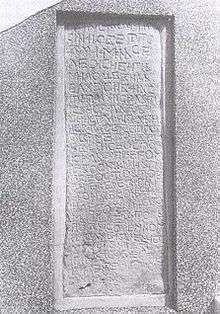Kočerin tablet
The Kočerin Tablet is a medieval tablet with an inscription written in Cyrillic in an archaic variant of Serbo-Croatian. It was made in 1404 or 1405 on the bottom of the stećak (tombstone) of Viganj Milošević,[1] in a necropolis in a field located close to the village of Kočerin,[1] 9 kilometers away from the city of Široki Brijeg, today in Bosnia and Herzegovina.[2] The stećak that the tablet that was written on top of was discovered in 1983 in Lipovci. In 1872, it was moved to Kočerin to the right side of the priest's office. In 1927, a new church was built in Kočerin, and a copy of the inscription was placed there. In 2004, it was moved to the inside of the Priest's office.[2]

The tablet measures 54 centimetres (21 in) across on the bottom, 49 centimetres (19 in) in the middle, and 50 centimetres (20 in) at the top. It measures 134 centimetres (53 in) in height. The top part is damaged.
Text
The tablet contains 25 rows of script, with 9-15 characters on each line. The tablet contains 300 Cyrillic characters in total, the largest known text in Bosnian Cyrillic.. In the tablet, it is mentioned that Milošević served five rulers: Banus Stjepan, King Tvrtko, King Dabiša, Queen Gruba, and King Ostoja.[1] The inscription ends by saying: имолꙋвасьненаст ꙋпаитенамеѣсмь билькаковиесте виꙉетебитикако вьсмьѣ ("And I pray you, do not tread on me. I was as you are; you shall be as I am.").
The text displays a large number of ligatures.[1] It is written in a Shtokavian Ikavian dialect, without nasal vowels, in a single-yer script, with some apparent Glagolitic influence.[3] The form svetago shows influence from Church Slavonic, but the rest of the inscription is free of Church Slavonicisms in its morphology.[3]
| Original text | Latin transliteration | Modernized Serbo-Croatian | English |
|---|---|---|---|
| ☩ ваимеѡцаи синаисветаго |
☩ va ime ōca i sina i svetago |
☩ U ime oca i sina i svetoga |
☩ In the name of the Father and the Son and the Holy |
References
- 2004. Šefik Bešlagić, Leksikon stećaka.
- "Hrvatska pošta Mostar". Archived from the original on 2012-04-25. Retrieved 2011-11-17.
- 2011. Mateo Žagar, review of Jezik srednjovjekovnih kamenih natpisa iz Hercegovine.